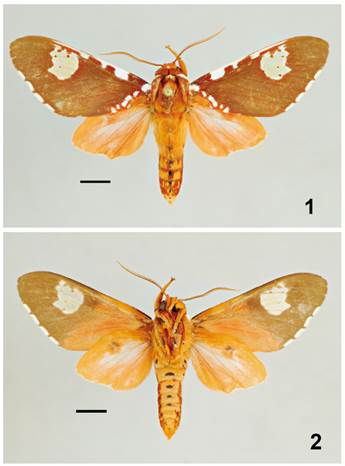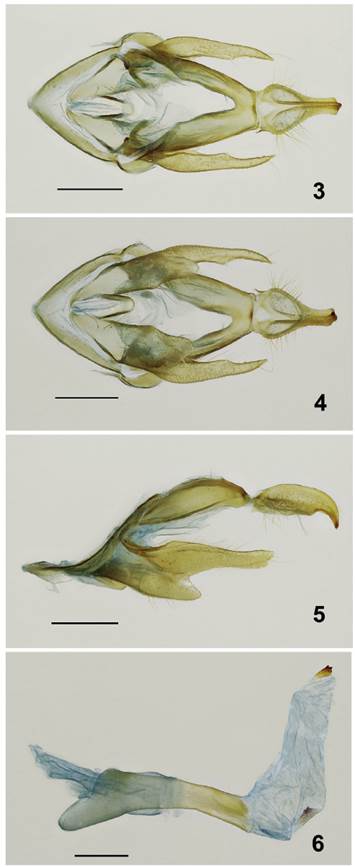Introduction
Prior to the reclassification of the genus AutomolisHübner [1819] by Watson (1975), it was known the existence of the "flammans" group, alluded to in part by Rothschild (1935) and Hayward (1947), subsequently refined by Grados and Ramírez (2016), presumably related. Watson (op.cit.) refers to the taxon Rhipha uniformis (Rothschild 1909) and the other species he placed under the genus Rhipha as follows: “I have hesitated to erect new genera for these wrongly placed species as the affinities of other possibly closely related species at present in other genera should first be investigated”. However, later referring to the species Rhipha fulminans (Rothschild) and related species "none of these species is congeneric with the type-species of Rhipha" it is necessary to know more to place them better in existing genera or form a new genus (Watson op. cit.).
Vincent & Laguerre (2014) mentioned 19 species within the genus Rhipha Walker. The species comprising the recent proposal of the new genus, Rhodorhipha Laguerre 2018, are the ones which made up the "flammans" group (Rothschild 1935, Hayward 1947, Grados & Ramírez 2016) and comprised 10 species. Recently Laguerre (2018) described four new species, placing them in the new genus.
A new species for the science, from the genus Rhodorhipha Laguerre is described. A male description and the genitalia characters are given, as well as differences with similar species.
Material and methods
The specimens have been collected with light traps, using 250W mixed light bulb, and were placed in killing jars containing butyl acetate.
Comparison with similar species were made possible by examination on holotypes kept at the following entomological collections:
IOC: Oswaldo Cruz Institute, Brazil.
MHNP: Muséum National d’Histoire Naturelle, Paris, France.
MUSM: Museo de Historia Natural, Universidad Nacional Mayor de San Marcos, Lima, Perú.
NHMUK: Natural History Museum, London, United Kingdom.
USNM: National Museum of Natural History, Smithsonian Institution, Washington DC, USA.
The specimens have been deposited in the MUSM. The terminology used for venation follows Comstock and Needman (1898, 1899), Miller (1970), Wootton (1979) and Common (1990); genitalia terminology follows Sibatani et al. (1954), Kuznetsov (1967) and Klots (1970).
Genitalia of the specimens were dissected and prepared using a KOH solution (10%) in a water bath. For a better observation of the characters, Chlorazole black was used as a staining solution, (Cannon 1937, 1941; Carayon 1969). Photographs of the adults were taken with a Nikon D80 camera and those of the genitalia with a Canon EOS Rebel T6 camera and a Canon MP-E 65mm macro. The genetic distances were calculated with the program Mega V.11 (Tamura et al. 2021).
Results
Orden: Lepidoptera
Familia: Erebidae Leach, [1815]
Subfamilia: Arctiinae Leach, [1815]
Tribu: Arctiini Leach, [1815]
Subtribu: Phaegopterina Kirby, 1892
Rhodorhipha Laguerre, 2018
Rhodorhipha dalyi sp. nov.
Diagnosis: Similar to R. andensis, being differentiated by the coloration: R. andensis is reddish brown and the base of the forewings has a blackish shade, while R. dalyi is reddish orange and the front wings have a uniform shade. As for the genitalia in R. andensis, the genital capsule is short, the base of the uncus has a large number of setae and the valva is elongated and curved towards the middle axis; in R. dalyi the genital capsule is elongated, the base of the uncus does not present as many setae, the valvae are somewhat elongated and present a developed saccus.
Male (Figs. 1-2: Length of the forewing: 22-24 mm (n=9).
Head: Proboscis brown. Head reddish orange; presents black spots at the base of the first and second palpomeres, and in the distal part of the third one. Ocellus black with a white spot behind it. Presence of white spots at the antennal alveolus and the vertex. Antennae half the length of the forewing, with axis brown ferruginous, rami brown and white spots at the scape; proximal rami small; middle rami twice the length of the flagelomere axis; the last six distal rami decreasing in size.
Thorax: Thorax, patagia and tegulae reddish-orange. Patagia with a small black spot at the central part and tegulae with a white spot towards the anterior part. A white spot on the anterior part of the mesoscutum and two small ones on the sides of the central part, covered by the tegulae. A white spot on the mesoscutellum, metascutum and metascutellum. First pair of legs reddish orange. Femora with a black spot at almost all the extension. Towards the proximal part of the tibia, right at the joint with the femur, a black spot and on top of this, a small white spot. Epiphysis blackish. Second and third pairs of legs reddish orange, both ends of the femora with black spots, and on top of the proximal black spots a small white spot; the distal black spots of the third pair of legs, without white spot. Proximal tibiae proximal end with a black spot and on these a white spot. Piliform scales on the tibiae. On the proximal end of the first tarsal segment of each leg, a black spot and on this, a small white spot.
Forewing (dorsal): Reddish orange, costal margin white and three white spots at the costal cell: the proximal rectangular, the central one dot shaped and the smallest, and distal one elongated. A hyaline area of irregular contour and preapical position with a white edge, comprising the proximal part of R4-R5 and R5-M1, the subproximal part of M1-M2 and M2-M3, and the upper-middle part of M3-Cu1, the edges more irregular towards the termen. At the termen it presents a thin elongated white spot, from close to the tornus up to the M2. A series of white spots, starting from the base of the wing, continuing until near the beginning of 1A+2A to go to the posterior margin, reaching up to almost half of its extension.
Forewing (ventral): With the same characteristics as the dorsal side, except for the ferruginous costal margin, the reddish orange proximal area presents elongated scales.
Hindwing (dorsal): Reddish orange, somewhat diaphanous towards the central part, with whitish scales present on the margin, from RS to 1A+2A.
Hindwing (ventral): Similar to the dorsal side.
Abdomen: Reddish orange with black dots on the central part of the tergites 3-7, on the latero-ventral part of the sternites 2-7 and on the central part of the sternites 2-6.
Male genitalia (Figs. 3-6): Tegumen wider in the anterior part, with its sides elongated; joining of the tegumen and uncus sclerotized. Uncus wide at its base, presenting setae, mainly on its sides, which are somewhat dilated; it narrows down towards its distal part; they present a more sclerotized carina from the base to the distal part; smaller than the tegumen; in lateral view, the distal part acuminate, directed towards the ventral part. Vinculum easily distinguishable, somewhat thickened and developed; saccus ending in somewhat acute form; valvae elongated and somewhat sclerotized, parallel to the axis of the genital capsule, short and sclerotized ventral process, with setae present in the ventral margin; dorsal and sclerotized process, somewhat wider at its base, reaching almost half of the uncus, inner side of this part presenting somewhat elongated setae. Adeagus elongated, coecum penis developed; vesica membranous and directed dorsally; cornuti patch on the ventro-distal part and another on the dorsal part.
Female: Unknown
Type material: HOLOTYPE male (Figs. 1-2): PERU. MADRE DE DIOS. Albergue Refugio Amazonas, 12°52'30''S, 69°24'35''W, 231 m, 19.iii.2017, Aaron Daly (VBC #00253 JGA-MUSM). PARATYPES: 1♂, Albergue Refugio Amazonas, 12°52'30''S, 69°24'35''W, 231 m, 01.x.2016, D. Couceiro et al. (Voucher VBC #00107 JGA-MUSM); 1♂, idem except, 23.ii.2017(VBC #00243 JGA-MUSM); 1♂, idem except, 19.iii.2017, Aaron Daly (VBC #00252 JGA-MUSM)(Genitalia JGA #964); 1♂, idem except, 10.vi.2017, D. Couceiro et al.; 1♂, idem except, 19.iii.2018, J.D. Shoobridge et al.; 1 ♂,idem except, 17.iv.2018; 1♂, idem except, 06.v.2018; 1♂, idem except, 08.v.2018. All deposited in the MUSM.

Figures 1-2 Rhodorhipha dalyi Grados, sp. nov. Holotype male. 1. Dorsal view. 2. Ventral view. Scales=5 mm.

Figures 3-6 Genitalia of Rhodorhipha dalyi Grados, sp. nov. Male (Genitalia # JGA-964). 3. Dorsal view. 4. Ventral view. 4. Lateral view. 6. Aedeagus. Scales= 1 mm.
Etymology: dalyi is a noun in genitive singular, dedicated to Aaron Daly for being one of the first to collect specimens of the new species at Refugio Amazonas Lodge.
Distribution: Known only from the department of Madre de Dios (Peruvian Amazon).
Barcoding: Free access codes in Boldsystem are: RFEWA243-17, RFEWA252-17 and RFEWA253-17. The mitochondrial DNA sequence (COI) of one of the paratypes is as follows (Voucher MUSM-Arctiinae VB # 00252; Process ID, RFEWA252-17).
AACTTTATATTTTATTTTTGGAATTTGAGCTGGAATAGTAGGGACTTCATTGAGATTATTAATTCGTGCTGAATTAGGAAATCCCGGATCATTAATTGGAGATGATCAAATTTACAATACTATTGTTACAGCACATGCTTTTATTATAATTTTTTTTATAGTTATACCAATTATAATTGGAGGATTTGGAAATTGATTAGTCCCACTAATACTAGGAGCCCCAGATATAGCTTTCCCCCGAATAAATAATATAAGTTTTTGACTTTTACCCCCATCTTTAACTTTATTAATTTCAAGAAGAATTGTAGAAAATGGAGCAGGAACAGGATGAACAGTTTACCCCCCACTTTCATCTAATATTGCTCATGGAGGAAGTTCTGTAGATTTAGCTATCTTCTCCTTACATTTAGCGGGAATTTCTTCAATCTTAGGGGCAATTAATTTTATTACAACAATTATTAATATACGATTAAATAATTTATCATTCGATCAAATACCTCTTTTTGTTTGGGCAGTAGGTATTACAGCATTTTTATTATTACTCTCACTACCTGTTCTAGCAGGAGCTATTACTATATTATTAACAGATCGAAATTTAAATACTTCATTCTTTGACCCAGCTGGAGGAGGAGATCCAATCCTTTATCAACATTTATTT
Remarks: Differences with R. andensis on the forewing coloration pattern are notorious, and the morphological ones are evident at the male genitalia. In regard to genetic differences, based on barcoding (COI), between five specimens of Rhodorhipha dalyi sp. nov. and one of R. andensis (Boldsystem Code MILA 1275), these were between 4.0% and 4.5%. Among Rhodorhipha dalyi sp. nov. (RFEWA243-17, RFEWA252-17, RFEWA253-17, RFEWA757-19 and RFEWA781-19) and R. amazonensis (Boldsystem Code INCTA310-10 and INCTA311-10/) were between 4.8% and 5.3%. The calculation parameters were: Bootstrap with 10000 replications, Kimura 2-parameter model, and transitions+transversion substitutions.
Discussion
There is no phylogenetic analysis of the genus that considers all species, however better knowledge the real richness of species, allows us, for now, to group related species by similarities, which will help later work. For now, the genus consists of 15 species with tree groups proposed by Laguerre (2018). The first called the group R. subflammans, where we find R. perflammans (Dognin), R. ignea (Grados & Ramírez), R. yanomami Laguerre, R. esperans Laguerre, R. amazonensis Laguerre and R. andensis Laguerre. Except for R. ignea, the other species present a preapical hyaline area, and on the dorsal side of the first pair of wings, white spots at the costal margin and at the base of the wings. In most cases analysis of the genitalia morphology of the males is necessary for identification.
A second group would comprise R. mathildae (Köhler), R. fulminans (Rothschild) and R. flammula (Hayward). The latter was described by two males and three females, recovered from cocoons from Fontana, National Territory of Chaco, Argentina. The species R. mathildae was described from only one male specimen from Misiones, Argentina, while R. fulminans was described from a female, according to the author (Rothschild 1916) from the southern Brazil, the holotype being at the NHMUK (examined). Recently Laguerre (2018) has slipped the idea that R. mathildae could be a recent synonym of R. fulminans. The controversy arises because Hayward (1947), in the only plate of his publication, focused at species from Argentina, presented a drawing of a male of R. fulminans. Unfortunately, no reference is made of this species in the text of his publication. Most likely, it is an error, since at the last page he mentions R. subflammans and R. mathildae. However, in his drawings, R. mathildae is easily identified. The third drawing, although in the legend refers to R. fulminans, has all the characteristics of R. subflammans. A third group would be formed by R. flammans (Hampson) and R. gurupi, two similar species based on the external morphology and male genitalia characters. The first one described from an unspecified place in Colombia. According to Laguerre (2018) there could be two very similar species, being necessary to know the genital morphology of the type (NHMUK). At least one of these two species occurs in Peru, in addition to the occurrence of R. gurupi (MUSM).
It is known that the genus has a wide geographic distribution in South America, however, it is almost certain that there are new species to be described, mainly in the middle altitudes of the montane forests of the Andes in Colombia, Ecuador, and Peru.












 uBio
uBio 


